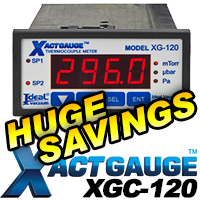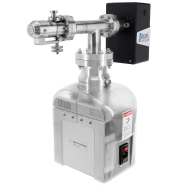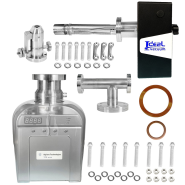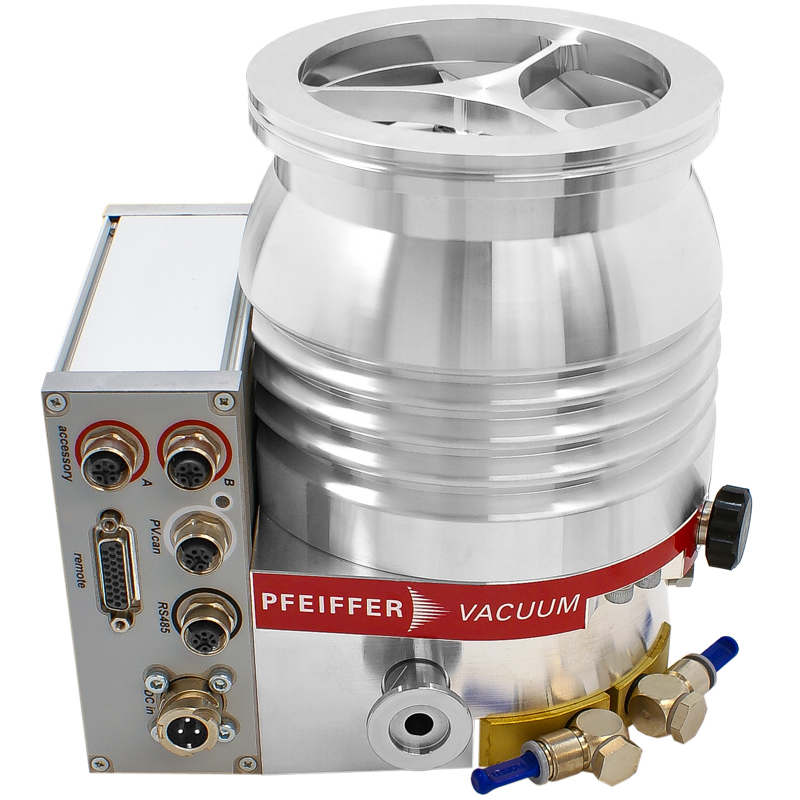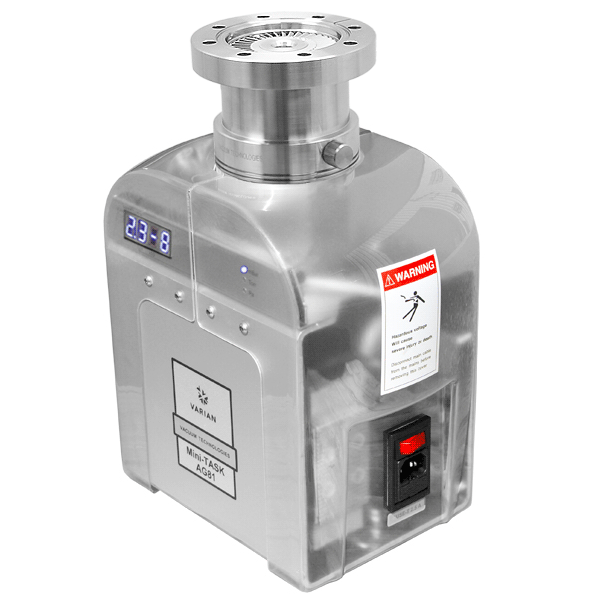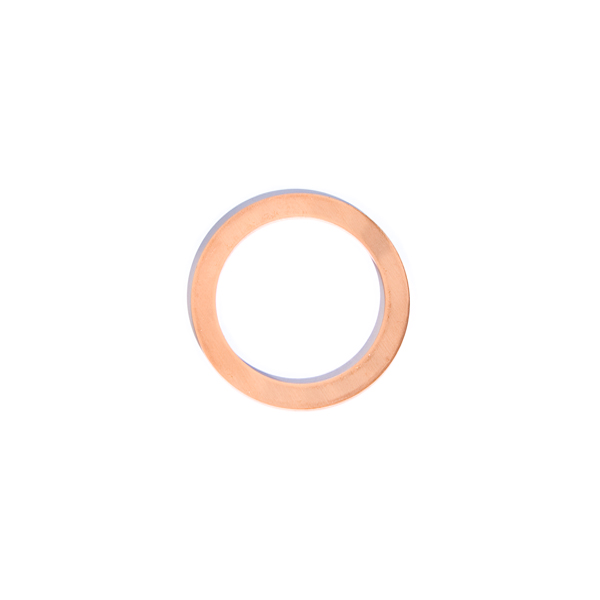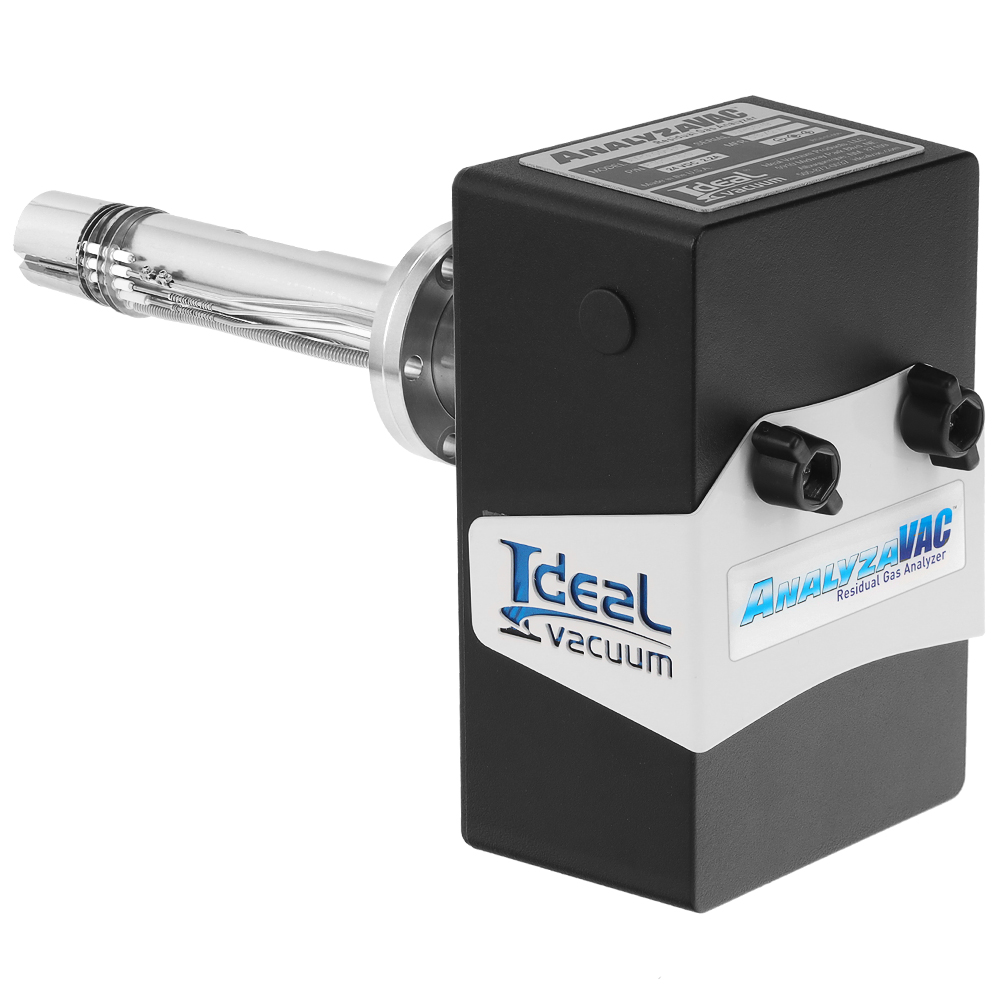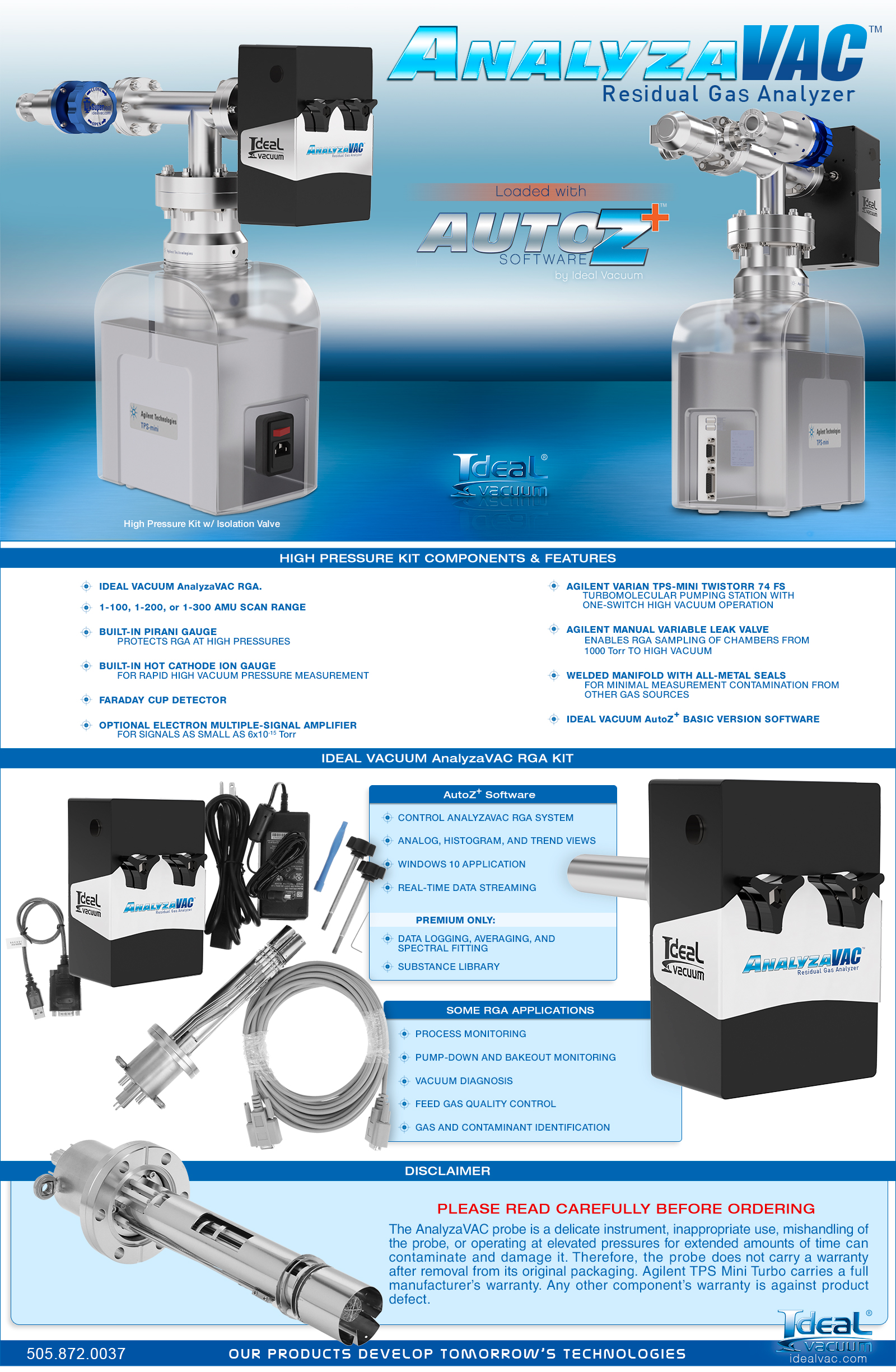The Ideal Vacuum AnalyzaVAC RGA is a compact mass spectrometer that can assist in determining the identity and concentration of residual gases inside a vacuum chamber. It can be used for leak detection, outgassing analysis, feed gas quality control in coating and etching applications, process troubleshooting, and more.
Connected directly to a chamber, the RGA is designed for continuous operation at total pressures below 1×10
-6 Torr, and optimally around 2×10
-7 Torr. Operation of the RGA at higher pressures leads to dramatically reduced ionizer, filament, and quadrupole lifetime. The AnalyzaVAC’s built-in pressure gauges are used both internally and in the included AutoZ
+ software to prevent fatal damage to the RGA (in most cases).
To measure gases in a chamber at medium vacuum to atmospheric pressure, the RGA must be placed in a separate, small chamber with its own high vacuum pumping system. The RGA vacuum system is then connected to the chamber via a leak valve which allows the RGA to sample gases in the main chamber while still maintaining high vacuum around the delicate quadrapole probe.
This kit contains everything you need to use an RGA to measure gases at higher pressures.
Components and Features:
- Ideal Vacuum AnalyzaVAC RGA.
- 1-100 AMU scan range.
- Faraday cup detector.
- Built-in Pirani gauge prevents RGA turn on at high pressures.
- Built-in hot cathode ion gauge for rapid high vacuum pressure measurement.
- Agilent Varian TPS-Mini TwisTorr 74 FS turbomolecular pumping station with one-switch high vacuum operation.
- Manual Agilent variable leak valve enables RGA sampling of chambers from 1000 Torr to high vacuum.
- Welded manifold with all-metal seals for minimal measurement contamination from other gas sources.
- Ideal Vacuum AutoZ+ basic version software.
The combination of the Agilent Varian TPS-mini pumping station with the manual Agilent variable leak valve enables accurate gas sampling of chambers spanning at least 9 orders of magnitude of pressure. However, a single isolation valve crack point is not suitable for all pressures within the range. For best results, the valve should be manually reset whenever the chamber pressure is changed. If the chamber pressure is going to rise more than 1 order of magnitude compared to the current operating pressure (i.e., during a chamber vent), the leak valve should be closed first to prevent damage to the RGA and pumping system. After the chamber reaches a stable pressure, the RGA ionizer should be turned off, and the valve reopened until the desired pressure inside the RGA subsystem is reached. The RGA ionizer may then be turned back on and measurement resumed.
To keep the leak valve at a certain crack point through pressure cycles, the RGA can be isolated from the chamber using an additional CF 1.33 in.
manual bellows valve.
About the Ideal Vacuum AnalyzaVac RGA:
The AnalyzaVAC operates by ionizing the gases present at the probe tip using electrons emitted thermionically by dual field-replaceable thoriated iridium filaments. The resulting cations are separated by mass-to-charge ratio using a combination of varying radio frequencies and DC voltages applied to the quadrupole filter. The positively charged ions travel down the center of the quadrupole and are either amplified by an electron multiplier or detected directly by the faraday cup detector at the end of the probe. Each gas produces a unique spectral fingerprint which is a combination of the natural isotopic abundance of its elements and molecular fragmentation caused by the RGA's high-energy electron ionization.
All AnalyzaVAC probes come with a Faraday cup detector which provides repeatable, quantitative, highly linear detection down to 1.5×10
-12 Torr
*. The optional electron multiplier increases the sensitivity to a staggering 6×10
-15 Torr
* for qualitative measurements. Both the standard and electron multiplier equipped detectors have 0.5 AMU resolution at 10% peak height (or better) when properly calibrated.
Ideal Vacuum’s non-expiring basic AutoZ
+ software is a Windows 10 application, that can control any AnalyzaVAC RGA system from a desktop or laptop computer. AutoZ
+ gives the operator the power to control all acquisition parameters. AutoZ
+ provides real-time data streaming and allows users to view collected data as an analog spectrum, a mass histogram, and trends over time. To remove unwanted peaks and spectral contributions, a user can use previously collected spectra to baseline data.
Ideal Vacuum’s optional premium AutoZ
+ software upgrade includes all the features of the basic software and adds advanced data logging, averaging, spectral fitting with access to Ideal Vacuum’s substance library, and the ability to add additional compounds to the library. Premium AutoZ
+ uses a powerful least squares algorithm to calculate the partial pressures of common residual gases, identifies their contribution to the currently displayed spectrum, and isolates unknown peaks. Premium software must be renewed annually, or it reverts to the basic version.
Some RGA Applications:
- Leak testing
- Process monitoring
- Pump-down and bakeout monitoring
- Vacuum diagnosis
- Feed gas quality control
- Gas and contaminant identification
Please read carefully before ordering:
*
The AnalyzaVAC probe is a delicate instrument. Inappropriate use, mishandling of the probe, or operating at elevated pressures for extended amounts of time can contaminate and damage it. Therefore, the probe. does not carry a warranty after removal from its original packaging.
Agilent TPS Mini Turbo carries a full manufacturer's warranty. Any other component's warranty is against product defect.
The optimal total operational pressure of the RGA is 2×10-7 Torr for most gases. External pressure may be much higher as long as it is reduced inside the RGA system using the variable leak valve and turbo pump system. Operation at higher RGA system pressures for extended lengths of time will results in premature aging of the probe, loss of gain, spectral drift, and fillament and ionizer burnout. The RGA can be used at the following pressure regions for the corresponding lengths of time:
10-4 Torr, several hours
10-5 Torr, several days
10-6 Torr, several months
10-7 Torr, several years
10-8 Torr, indefinitely
Organic vapors should be kept at a 2x lower pressure than atmospheric gases to prevent soot contamination of the fillament and ionizer. Silicone vapors should be kept at pressures at least 10x lower than atmospheric gases to prevent glass buildup on the fillament and ionizer. Corrosive vapors are also more damaging to the RGA than normal gases. By properly managing pressure, the RGA can be used to measure these gases without incurring costly repairs.
*
Measured with nitrogen gas, 5 second dwell time, 1 amu full peak width, 10% height, 70 eV electron energy, 6 eV ion energy, and 2 mA electron emission, and calculating three standard deviations from baseline noise.




